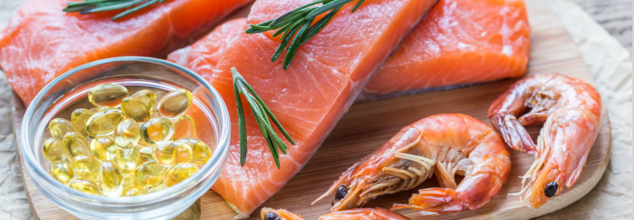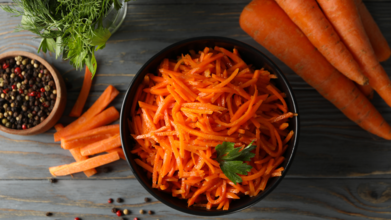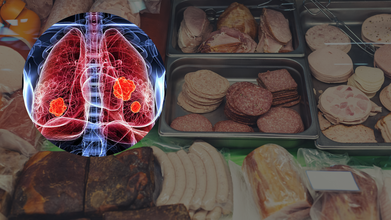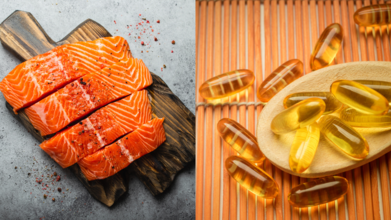- Health Conditions A-Z
- Health & Wellness
- Nutrition
- Fitness
- Health News
- Ayurveda
- Videos
- Medicine A-Z
- Parenting
- Web Stories
13 Superfoods High In Omega-3 Fatty Acids

13 Superfoods High In Omega-3 Fatty Acids
Omega-3 fatty acids are of essential in boosting both brain health and heart health, ensuring general bodily functions are maintained. These healthy fats build structure into cell membranes, assist cognitive functions, provide enhancement in mood stability, and boost immunity. Since the body cannot make all types of omega-3 fatty acids, dietary incorporation is very important.
Omega-3 contents vary with species but, in general, provide adequate DHA and EPA.
Omega-3 fatty acids are necessary to maintain optimal mental and physical well-being. While fatty fish like salmon, sardines, and anchovies are great sources of EPA and DHA, there are plant-based options such as flaxseeds, chia seeds, walnuts, and soybeans that are rich in alpha-linolenic acid or ALA. Adding these 13 foods to your diet will greatly improve heart health, brain function, and your overall well-being. Whichever your preference, fish, legumes, seeds, or even plant-based alternatives, you can find an omega-3.
Here are 13 foods that are very high in Omega-3 fatty acids and are nutritious:
1. Salmon
Salmon is one of the most nutrient-dense foods available and a top source of omega-3 fatty acids. It is rich in both EPA (eicosapentaenoic acid) and DHA (docosahexaenoic acid), two critical types of omega-3s. Besides, salmon offers many essential nutrients, including vitamin D, vitamin B12, and selenium. Some research findings reveal that consuming salmon regularly will lower your risks for heart diseases, dementia, and mental problems, like depression. Salmon is indeed the epitome of versatility. Salmon may be grilled, baked, smoked, or poached, but will fit into almost any diet.
Omega-3 content: 2,150 mg of EPA and DHA (combined) per 3.5 oz (100 g) serving.
2. Cod Liver Oil
Although technically a supplement, cod liver oil deserves mention for its exceptional concentration of omega-3s.
Extracted from the liver of cod fish, this oil is an incredibly efficient source of essential omega-3 fatty acids. It is also loaded with vitamins A and D. One tablespoon of cod liver oil delivers 170% of the daily recommended value of vitamin D and 453% of vitamin A. It should be consumed in moderation, though as excess vitamin A can cause damage to your body. Cod liver oil has been shown to promote heart health, even brain functioning, and improve bone and immune system response.
3. Oysters
Oysters are a popular shellfish and are an excellent source of zinc, copper, and vitamin B12. They are also high in omega-3 fatty acids. They can be consumed raw, grilled, or baked and provide the best option for those looking for a nutrient-dense appetizer or main dish. Nutritionally, oysters are potent due to their combination of omega-3s and essential trace minerals, which help with heart health, immunity, and recovery from fatigue.
Contains omega-3 content: 500 mg per 3 oz serving
4. Sardines
These small oily fish pack a nutritional punch. Sardines are nutrient-rich and are an excellent source of omega-3s. When eaten whole, you also get the calcium, vitamin B12, and vitamin D that they are so rich in. They come usually canned and can be added to pasta dishes, salads, or eaten alone as a healthy snack.
Omega-3 content: 1,463 mg of EPA and DHA (combined) per cup (149 g) of canned sardines.
5. Anchovies
Anchovies are small, oily fish with both a good taste and nutritional value. They are usually sold canned or dried and have a very pungent flavor, making them suitable for use as ingredients in sauces, pizza toppings, or any other dishes. Not only do anchovies contain an impressive amount of omega-3 fatty acids, but they are also a good source of niacin and selenium. They also contain a good amount of calcium when consumed with bones.
Omega-3 content: 2,053 mg of EPA and DHA (combined) per 3.5 oz (100 g).
6. Shrimp
Shrimp is an ambrosial seafood food widely consumed by people across the world. It has very low calorie levels and high protein, rich in omega-3. It can be grilled, boiled, or mixed with salads and pasta to be a heart-friendly dish. Besides the richness of omega-3, it has a high content of potassium that helps the heart maintain health.
Omega-3 content: 0.12 g of DHA and 0.12 g of EPA per 3 oz (85 g) serving.
7. Chia Seeds
Chia seeds are a fantastic plant-based source of ALA, which is a type of omega-3 fatty acid. They're also super versatile and can be used in a number of dishes. With its high fiber and protein content, chia seeds are excellent for digestion and satiety. Commonly used to make chia pudding, sprinkled over salads, or added to smoothies.
Omega-3 content: 5.055 g of ALA per 1 oz serving.
8. Flaxseeds
Other top plants from where sources are gotten include flaxseeds, which contain omega-3 fatty acids. Flaxseed are extremely loaded with fiber, protein, magnesium, and manganese to mention a few. Flaxseed oil is also fantastic since it contains 6.703 g of ALA per tablespoon. Flaxseeds are easy to be included in your diet because they can be easily put on cereals, oatmeal, or salads.
Omega-3 content: 6.703 g of ALA per tbsp.
9. Edamame Beans
Edamame beans are young soybeans, usually eaten as a snack or side dish. A good source of protein, they also contain omega-3 fatty acids, which boost heart health and overall wellbeing. They can be simply steamed, boiled or added to stir-fries, soups, and salads to give an easy, nutritional boost.
Omega-3 content: 0.28 g of ALA per 1/2 cup serving.
10. Kidney Beans
Kidney beans are a staple for hearty stews, chili, and other comfort foods. While not as high in omega-3s as fish sources, they are still a good plant-based option. They are also a good source of dietary fiber, which supports digestion and heart health.
Omega-3 content: 0.10 g of ALA per half-cup serving.
11. Soybeans
Soybeans are versatile legumes rich in fiber, vegetable protein, and several essential vitamins and minerals. Though better known for their omega-6 fatty acids, they do provide a decent amount of omega-3s. Tofu and soy milk products are good sources for heart-healthy benefits and add to the overall intake of omega-3s.
Omega-3 content: 670 mg per serving.
12. Walnuts
Walnuts are an excellent source of ALA omega-3s and are a favorite for their versatility. They can be eaten on their own, mixed into granola, or added to salads and other dishes. Walnuts also provide a hearty dose of healthy fats and contribute to better brain function, cardiovascular health, and overall wellness.
Omega-3 content: 3.346 g of ALA per 1 cup.
13. Seaweed and Algae
For vegetarians and vegans, seaweed and algae are great plant-based sources of omega-3s. They are rich in both EPA and DHA and are widely consumed in sushi, soups, and supplements. Adding seaweed and algae can be a good way to meet daily omega-3 needs without consuming fish.
Ways You Can Add Omega-3 Rich Food To Your Diet
Incorporate these omega-3-rich foods into your daily diet with simple swaps and additions.
Begin by enjoying two servings of fatty fish like salmon, sardines, or shrimp a week.
Sprinkle chia seeds or flaxseeds into smoothies, oatmeal, or yogurt for a plant-based ALA boost. Add edamame or kidney beans to your salads or soups to enhance protein and omega-3s. Use walnuts in your granola, trail mix, or as a snack. Replace regular oils with flaxseed or fish oil for cooking or dressings. Take cod liver oil as a supplement. These little changes will make a big difference in supporting overall health.
'Eat Your Skin Care' What This Online Trend Really Mean

Credits: Canva
It started with a simple TikTok video, four large carrots shaved into ribbons, mixed with garlic, sesame oil, lime juice, coconut aminos, rice vinegar, and green onions. The resulting “crunchy and addictive” salad quickly racked up millions of views under the viral trend #EatYourRetinol. But is it just social media hype, or can what’s on your plate really show up on your face?
The trend encourages eating vitamin A-rich foods, like carrots, to support skin health from the inside out. “Skincare always starts within,” says Johanna Salazar, registered dietitian nutritionist and founder of Healing Nutrition, as noted by Martha Stewart. But experts urge a balanced view: while diet can support your skin, it’s not a magic replacement for topical care.
What’s in the Carrot Salad That’s Good for Your Skin?
The base of the salad, carrots, are packed with beta-carotene, a precursor to vitamin A, known for boosting skin cell turnover and promoting a radiant complexion. Pairing it with a fat, like sesame oil, helps your body absorb the fat-soluble vitamin. Lime juice adds vitamin C, key for collagen production, while garlic and green onion offer prebiotics that support gut health, which in turn impacts skin health.
Sesame seeds sprinkled on top bring in vitamin E and fiber, which contribute to skin hydration and a healthy glow.
“It’s a nice mix of ingredients that all play small but beneficial roles in skin support,” says Salazar.
Dermatologists Weigh In: Not a Cure-All
Lauren Kole, M.D., associate professor of dermatology at the University of Alabama at Birmingham, appreciates the effort to eat for skin health—but with a word of caution.
“Deficiencies in certain vitamins and minerals can negatively affect the hair, skin, and nails,” she says. “But eating an excess doesn’t necessarily make your skin better.”
Kole points out that while beta-carotene from carrots is helpful, it's not strong enough to replace prescription retinol or other topical treatments for conditions like acne or hyperpigmentation. “Diet is not a substitute for proper skin care,” she emphasizes.
Beyond Carrots: Other Skin-Loving Foods
Experts agree that eating for your skin isn’t just about one salad. A variety of fruits, vegetables, and healthy fats are essential. Salazar and Kole both recommend incorporating:
Dark-colored fruits like berries and red grapes, which are high in antioxidants that fight oxidative skin damage.
Leafy greens such as spinach, kale, and chard, which are rich in vitamin C and help with collagen production.
Vegetables like broccoli, mushrooms, and cauliflower, which support healthy pigmentation and skin repair.
Healthy fats including avocados, walnuts, flaxseeds, and omega-3-rich foods to reduce inflammation and maintain skin moisture.
According to Kole, diets like the Mediterranean diet—rich in plant-based foods and good fats, have shown potential skin benefits in clinical settings.
Don’t Ditch Your Skincare Just Yet
While the “Eat Your Retinol” movement has its heart in the right place, Salazar and Kole stress that no food trend should replace professional skincare or personalized advice.
Lizzy Davis, Ph.D., a dietitian and assistant professor at UAB, advises people to approach such trends with balance.
“Cooking carrots, for example, doesn’t reduce their skin-friendly fiber,” she notes. “It can actually make them easier to digest and still beneficial.”
Davis also warns against over-relying on TikTok or Instagram for skincare advice. “Talk to your doctor or a registered dietitian,” she says. “Social media is convenient, but it can’t give you a plan tailored to your needs.”
Not Just Cigarettes, But Your Food Too Could Increase Your Chance Of Lung Cancer

Credits: Canva
We already know that ultraprocessed foods are linked to obesity, heart disease, and diabetes. But now, a new study published in the medical journal Thorax suggests a concerning addition to that list, lung cancer.
According to researchers, people who consume the highest amounts of ultraprocessed foods may face a 41% higher risk of being diagnosed with lung cancer, compared to those who eat the least, even when accounting for smoking and other known risk factors.
What Are Ultraprocessed Foods?
Ultraprocessed foods are industrial formulations made largely or entirely from substances not typically used in home cooking.
According to the Food and Agriculture Organization of the United Nations, these include artificial colorings, preservatives, emulsifiers, and chemically altered fats, sugars, or salts.
Common examples? Think sodas, chips, packaged soups, processed meats like chicken nuggets and cold cuts, instant noodles, diet soft drinks, and even some ice creams.
These additives enhance taste, shelf-life, and appearance, but at what cost?
What Does The Study Reveal About Food Choices and Lung Cancer Risk
Researchers behind the Thorax study analyzed data from over 100,000 adults who participated in the U.S. National Health and Nutrition Examination Survey. Each person filled out a detailed dietary questionnaire, which researchers then compared with medical records to track lung cancer diagnoses over time.
On average, people reported eating nearly three servings of ultraprocessed food a day, most commonly lunch meats and soft drinks.
Despite adjusting for smoking habits, age, sex, and other lifestyle factors, the study found a clear association between higher ultraprocessed food intake and increased lung cancer risk, particularly among people who had never smoked.
“This strongly suggests that these foods may contribute to lung cancer risk in ways beyond just smoking,” said Dr. David Katz, a specialist in preventive and lifestyle medicine and founder of the nonprofit True Health Initiative, as reported by CNN. Though not involved in the study, Katz called the findings “concerning and credible.”
Why Would Food Be Linked to Lung Cancer?
Experts believe multiple mechanisms could be behind the link.
“Industrial processing alters the food matrix,” the study authors explained, “which affects how nutrients are absorbed and may produce harmful contaminants.”
One such contaminant is acrolein. It is a toxic compound found not only in cigarette smoke, but also produced when cooking oils or fats are heated to high temperatures.
The U.S. Centers for Disease Control and Prevention (CDC) lists acrolein as a substance that can inflame and damage lung tissue.
Packaging may also be a problem. Plastics and synthetic materials used in food storage can leach chemicals, some of which are known or suspected carcinogens.
Add to that the fact that ultraprocessed foods are often low in omega-3 fatty acids, said Dr. Tom Brenna, professor of nutrition and chemistry at the University of Texas at Austin, as reported by CNN.
“Omega-3s spoil easily, so manufacturers tend to remove them to increase shelf life,” he explained. That’s unfortunate, because omega-3s help reduce inflammation, a key process in cancer development.
Smoking Isn’t the Only Risk Factor
Lung cancer remains one of the most commonly diagnosed cancers globally, with 2.4 million new cases in 2022, according to the World Health Organization. While smoking remains the leading risk factor, experts now believe diet and environmental exposures also play a role.
Dr. Fang Fang Zhang, a professor at Tufts University’s Friedman School of Nutrition Science and Policy, as reported by CNN, noted that while the study adjusted for smoking, the adjustment may not have been thorough enough. “Smoking needs to be measured more precisely, by cigarettes per day or years of exposure,” she said. Still, she found the link stronger in non-smokers, which makes the data all the more compelling.
What You Can Do: Eat More Whole Foods
The takeaway? While more research is needed to understand the exact biological mechanisms at play, the connection between ultraprocessed foods and cancer risk can no longer be ignored.
According to Dr. Katz, the solution lies in going back to basics. “Health and diet quality improve when people eat mostly whole, unprocessed foods,” he said, including vegetables, fruits, beans, whole grains, nuts, seeds, and other plant-based ingredients.
Dr. Zhang agrees. “Avoid foods with long ingredient lists full of unfamiliar chemicals,” she advised. “Focus on meals made from whole or minimally processed ingredients whenever possible.”
From PMS to Postpartum, Heart to Hormones: Why Fish Oil is the Ultimate Health Elixir for Every Woman at Every Stage

Fish oil is a star supplement loaded with omega-3 fatty acids like EPA and DHA. It offers a spectrum of vital benefits for women’s health. These extend beyond general well-being to support heart, brain and joint function, especially in areas of concern specific to women.
Fish oil, rich in omega-3s, addresses unique needs across all stages of a woman’s life. From adolescence through motherhood to menopause, fish oil supports cardiovascular, hormonal, mental and reproductive health.
A Boost for the Heart
Fish oil plays a major role in promoting heart health. According to Dr Mohit Bhatia, it helps lower triglyceride levels, a risk factor for cardiovascular disease, and improves blood flow, making it essential for proper cardiovascular function. He adds that it also slows the progression of cardiovascular disease.
Karan Khurana, a health expert at WishNew Wellness, concurs, saying that omega-3s in fish oil reduce triglycerides, lower blood pressure, and decrease arterial inflammation. This is particularly vital for post-menopausal women, who face a greater risk of heart disease. Regular consumption of fish oil, he says, can even lower the risk of heart attacks and strokes.
Hormones, Menstrual Cycles and PMS
Women facing bloating, mood swings or cramps may find some relief with fish oil. Dr Bhatia says that some evidence-based research suggests fish oil can help alleviate PMS and menstrual pain, thanks to its anti-inflammatory properties.
Khurana elaborates that omega-3s may regulate menstrual cycles and reduce cramps by lowering prostaglandin levels, which contribute to pain and inflammation. He adds that fish oil can ease common PMS symptoms such as bloating and breast tenderness.
Pregnancy, Postpartum and a Baby’s Brain
The benefits of fish oil carry into pregnancy too. Dr Bhatia points out the importance of DHA during this stage, saying it is vital for healthy foetal brain and eye development. It may also reduce the risk of preterm birth and help alleviate postpartum depression.
Khurana backs this up, pointing out that fish oil supplementation not only supports cognitive function in babies but also helps mothers manage postpartum depression. It plays a role in maintaining the mother’s brain health during and after pregnancy.
Bones, Joints and the Menopause Years
Post-menopause, bone health becomes a serious concern for many women. Dr Bhatia says that the anti-inflammatory properties of fish oil can contribute to bone health, potentially reducing the risk of osteoporosis.
Khurana adds that omega-3s enhance calcium absorption and support bone density. Fish oil, he explains, helps reduce inflammation linked to joint pain, promoting stronger bones and better mobility for older women.
Better Moods and Sharper Minds
Women are more likely than men to experience anxiety and depression, and fish oil might just help. Dr Bhatia explains that these fatty acids play a role in elevating mood and supporting brain function, potentially mitigating cognitive decline.
Khurana agrees, saying omega-3s support cognitive health and reduce the risk of dementia later in life. Fish oil, he says, may alleviate symptoms of depression and anxiety, contributing to overall mental well-being.
Your Skin Will Thank You Too
Dr Bhatia does not touch on it, but Khurana dives into skin benefits. He says that fish oil improves hydration, reduces wrinkles, and protects against UV damage. Its anti-inflammatory effects can ease conditions like eczema, making skin look and feel healthier.
Final Thoughts Before You Pop That Capsule
Dr Bhatia emphasises that while fish oil is a powerful supplement, it should complement a balanced diet and healthy lifestyle. He strongly recommends consulting a healthcare professional before starting, especially for those on medication or with existing conditions.
Khurana suggests aiming for 250–500 mg of combined EPA and DHA daily, either through fatty fish like salmon or through supplements. Fish oil, he concludes, is a holistic powerhouse that can help women thrive at every stage of life.
© 2024 Bennett, Coleman & Company Limited

